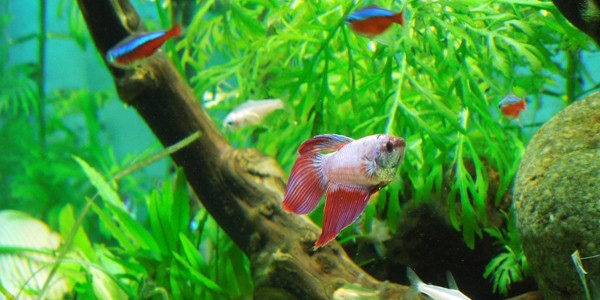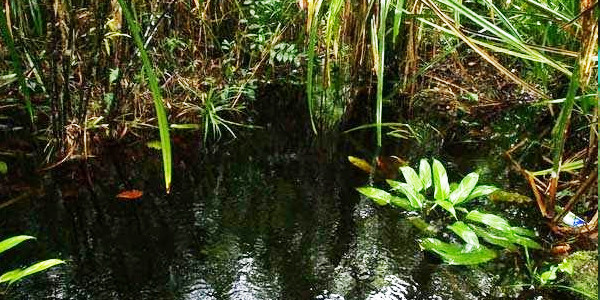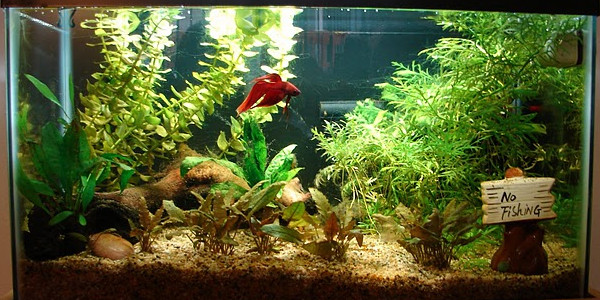Setting up a new betta aquarium can be a scary proposition. What type of fish do should you get? What temperature should the water be? What equipment will you need?
This can be especially troublesome when you want to setup a new tank with a Betta, one of many fish that have some special requirements.
And one of the most colorful freshwater fish too!
Worrying about these and other concerns won’t lead to any positive outcomes.
Instead of worrying, you should research your available options and make decisions from an informed viewpoint.
Let’s dive deeper into setting up a betta aquarium the right way.

Table of Contents
The Aquarium
The most basic component of any betta aquarium is the tank itself.
Space and budget considerations will definitely come into play, but experts recommend a 5-gallon (or larger) tank to create an ideal space for your betta.
In an effort to recreate the fish’s natural environment, aim for a long and relatively short tank to mimic the shallow streams that the fish originate from.
Keep the tank out of direct sunlight, but make sure it is still in the open with plenty of free space overhead. Bettas are known to interact and don’t enjoy swimming in the dark.
The Filters
Almost every variety of fish requires water filtration.
While the Betta is no exception to this rule, they are not fond of currents.
Their habitat consists of shallow, mostly standing water and that’s what should be recreated for them in the tank.
Check out an example of betta natural habitat below:

Any smooth-flowing filter should be fine for a Betta as long as it does not stir up the water or create strong currents.
A little motion is acceptable since it’s really unavoidable and the cleaner the water the healthier the fish.
If your selected filter does seem to be creating too much current, consider adding some extra plants or other items to slow down the flow.
The Heaters
The shallow waters Bettas are used to are mostly located in tropical zones, which means you’ll want the aquarium to have a nice, tropical feel to it, including tropically tempered water.
Bettas require water that is in between 77 and 80 degrees Fahrenheit year round.
For most locations in the US, that means a heater is necessary.
This is another area where tank size is important; smaller tanks can be subject to rapid temperature fluctuations when heaters are attached.
Keep the aforementioned tank size (five gallons or larger) in mind when selecting a heater.
ViaAqua Submersible Aquarium Heater
The Base layer and Plants
Gravel or sand is not just an aesthetic addition, but it also serves the purpose of anchoring plants and other decorations.
While this is definitely a positive addition, it also creates a negative aspect.
Uneaten food and other detritus will fall down and can become lodged between bits of gravel; left unchecked, this will lead to cloudy and dirty water.
Consider using a substrate as opposed to sand or gravel.
Live plants can be grown in the substrate and provide better aeration in the tank. They also give fish places to explore and hide.
The Decorations

Now it’s time to really get your creative juices flowing!
Decorating your tank is where you can let your artistic side show.
Many people consider creating a theme for their tank, be it the fish’s natural habitat or something a little more artistic, but that’s a decision up to the individual aquarist’s taste.
Something you want to avoid adding to your tank is any decoration with sharp edges including plant pots or fake plants with sharp edges.
Bettas like to dart in and out of tight spaces so if there are sharp edges in the tank, the Betta can injure itself.
Final Steps To Your Betta Aquarium
Now that everything is in place, there’s only one thing left to do right? WRONG!
Don’t add your fish yet; we still need to take a final look at the water in the tank.
Check Water Parameter
We’ve already discussed ideal temperature (77-80 degrees Fahrenheit), but there are a couple of other aspects that must be checked.
The pH balance is crucial for fish health and ideally should be a level 7.
Other chemicals that you’ll want to be on the lookout for include nitrites and ammonia; the ideal amount for both is zero.
There are testing supplies available at any aquarium supply store that will give you quick and accurate results for all three.
Cycle The Water
Once everything is in order, chemically speaking, you’ll want to run the aquarium for a day in what is referred to as a fishless cycle.
This simulates everything in the aquatic environment except for the fish.
This will allow beneficial bacteria to build up in both the tank and the filter as well as allow you to visually inspect everything prior to moving the fish into its new home.
Once all your readings are stable after the fishless cycle, add your new friend to the tank and let the good times roll!
Check out some beautiful betta aquarium on our pinterest.

2 thoughts on “Setting Up a Betta Aquarium Properly”
Mine seems to thrive well in our community tank.
And I bet you have enough space and hiding places for other fishes to swim away when your betta do decide to chase them. =)